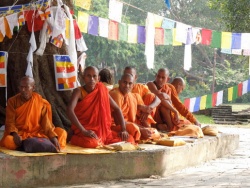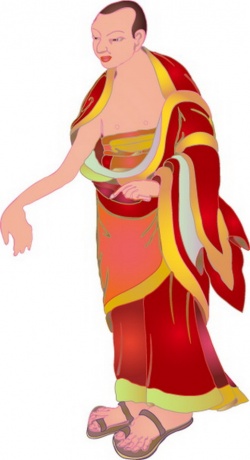Buddha: First Sermon - The Middle Path (c. 6th Century BCE)
from T.W. Rhys Davids and Herman Oldenberg, trans, Vinaya Texts, in F. Max Mueller, ed., The Sacred Books of the East, 50 vols., (Oxford: Clarendon, 1879-1910), Vol 13. pp. 94-97, 100-102 repr. in Alfred J. Andrea and James H. Overfield, The Human Record: Sources of Global History, Vol 1, 2d. ed., (Boston: Houghton Mifflin, 1994), pp. 72-74
[Andrea Introduction] Many parallels exist between the legendary lives of the Mahavira (the founder of the Indian philsophy of Jainism) and the Buddha, and several of their teachings are strikingly similar. Each rejected the special sanctity of (the Old Indian) Vedic literature, and each denied the meaningfulness of caste distinctions and duties. Yet a close investigation of their doctrines reveal substantial differences.
Like the Mahavira, young Prince Siddhartha Gautama, shrinking in horror at the many manifestations of misery in this world, fled his comfortable life and eventually became an ascetic. Where, however, the Mahavira found victory over karma in severe self-denial and total nonviolence, Prince Gautama found only severe disquiet. The ascetic life offered him no enlightenment as to how one might escape the sorrows of mortal existence. After abandoning extreme asceticism in favor of the Middle Path of self-restraint, Gautama achieved Enlightenment in a flash while meditating under a sacred pipal tree. He was now the Buddha.
Legend tells us he then proceeded to share the path toEnlightenment by preaching a sermon in a deer park at Benares in northeastern India to five ascetics, who became his first disciples. Buddhists refer to that initial sermon as "Setting in Motion the Wheel of the Law," which means that the Buddha had embarked on a journey (turning the wheel) on behalf of the law of Righteousness (dharma).
The following document is a reconstruction of that first sermon Although composed at least several centuries after Siddhartha Gautama's death it probably contains the essence of what the Buddha taught his earliest disciples
SETTING IN MOTION THE WHEEL OF THE LAW
And the Blessed one thus addressed the five Bhikkhus (monks). ' "There are two extremes, O Bhikkhus, which he who has given up the world, ought to avoid. What are these two extremes'? A life given to pleasures, devoted to pleasures and lusts: this is degrading, sensual, vulgar, ignoble, and profitless; and a life given to rnortifications: this is painful, ignoble, and profitless. By avoiiding these two extremes, O Bhikkhus, the Tathagata [a title of Buddha meaning perhaps "he who has arrived at the truth"] has gained the knowledge of the Middle Path which leads to insight, which leads to wisdom which conduces to calm, to knowledge, co the Sambodhi total enlightenment, to Nirvana (state of release from samsara, the cycle of existence and rebirth.
The Eightfold Path
"Which, O Bhikkhus, is this Middle Path the knowledge of which the Tathagata has gained, which leads to insight, which leads to wisdom, which conduces to calm, to knowledge, to the Sambodhi, to Nirvana? It is the Holy Eightfold Path, namely,
Right Belief understanding the truth about the universality of suffering and knowing the path to its extinction,
Right Aspiration [a mind free of ill will, sensuous desire and cruelty,
Right Speech [abstaining from lying, harsh language and gossip],
Right Conduct [avoiding killing, stealing and unlawful sexual intercourse],
Right Means of Livelihood [avoiding any occupation taht brings harm directly or indirectly to any other living being),
Right Endeavor [avoiding unwholsome and evil things],
Right Memory awareness in contemplation],
Right Meditation. (concentration that ultimately reaches the level of a trance),
This, O Bhikkhus, is the Middle Path the knowledge of which the Tathagata has gained, which leads to insight, which leads to wisdom, which conduces to calm, co knowledge, to the Sambodhi, to Nirvana.
The Four Noble Truths
"This, O Bhikkhus, is the Noble Truth of Suffering: Birch is suffering; decay is suffering; illness is suffering; death is suffering. Presence of objects we hate, is suffering; Separation from objects wc love, is suffering; not to obtain what we desire, is suffering. Briefly,... clinging to existence is suffering.
"This, O Bhikkhus, is the Noble Truth of the Cause of suffering Thirst, which leads to rebirth, accompanied by pleasure and lust, finding its delight here and there. This thirst is threefold, namely, thirst for pleasure, thirst for existence, thirst for prosperity.
"This, O Bhikkhus, is the Noble Truth of the Cessation of suffering: it ceases with the complete cessation of this thirst, -- a cessation which consists in the absence of every passion with the abandoning of this thirst, with doing away with it, with the deliverance from it, with the destruction of desire.
"This, O Bhikkhus, is the Noble Truth of the Path which leads to the cessation of suffering: that Holy Eightfold Path, that is to say, Right Belief, Right Aspiration, Right Speech, Right Conduct, Right Means of Livelihood, Right Endeavor, Right Memory, Right Meditation....
"As long, O Bhikkhus, as I did not possess with perfect purity this true knowledge and insight into these four Noble Truths... so long, O Bhikkhus, I knew that I had not yet obtained the highest, absolute Sambodhi in the world of men and gods....
"But since I possessed, O Bhikkhus, with perfect purity this true knowledge and insight into these four Noble Truths... then I knew, O Bhikkhus, that I had obtained the highest, universal Sambodhi....
"And this knowledge and insight arose in my mind: "The emancipation of my mind cannot be lost; this is my last birth; hence I shall not be born again!"


